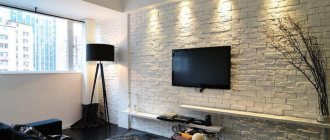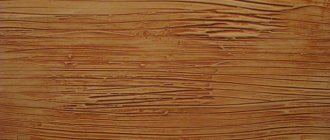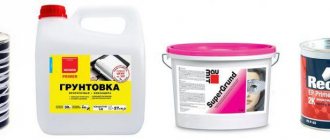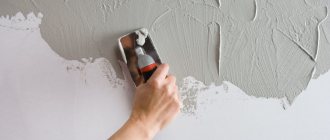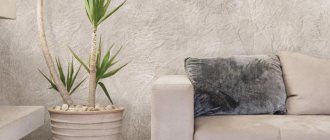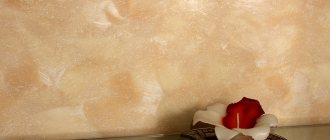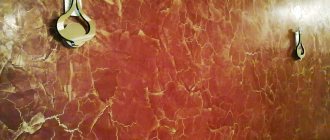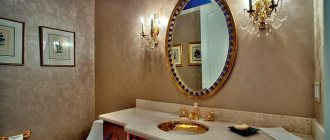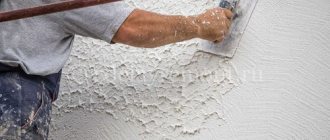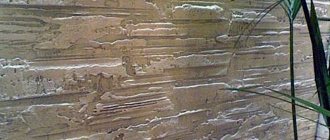Preparing walls for plastering is an intermediate procedure between leveling the walls and applying a decorative layer. This stage is considered one of the most important, since the quality of the work determines the future appearance of the surfaces, their service life, as well as strength and resistance to moisture, temperature changes, and so on. Most decorative plasters do not require perfectly smooth walls, but their surface must be clean.
It should be immediately noted that preparing walls for decorative plaster is practically no different from preparing for painting or wallpapering. With the clarification that such a plastic material as decorative plaster can smooth out some unevenness and close cracks or small potholes. Before you begin preparing the surface for plastering, you need to stock up on the necessary tools and materials.
What is needed for preparation
Preparing walls for decorative plaster requires the following tools and consumables:
Tools necessary for preparing walls for decorative plaster
- spatulas;
- building level and plumb line;
- sandpaper, sanding machine with polishing and cutting wheels;
- paint brush;
- drill with impact function (the hammer drill is too heavy and powerful for this work);
- plastic film, masking tape or tape;
- sponges and rags;
- screwdrivers;
- mixer attachment;
- mixing container;
- putty;
- solvent;
- primer.
A spray bottle may also be required. If the walls were previously covered with wallpaper, then they may have to be soaked using this product.
How the preparatory work is carried out
It should be said right away that this work should be one of the last to be carried out. That is, at the time they begin, double-glazed windows and door frames must be installed in the apartment, the flooring must be laid and ready for use. In general, all work has been completed that may directly or indirectly appear on the surfaces of the walls.
The room must be completely ready for decorative finishing
Preparing walls for decorative plaster includes the following steps:
- The first step is to remove the remnants of the old coating, such as wallpaper, paint or putty. The wallpaper is removed with a spatula after preliminary soaking, the paint is washed off with a solvent, and the putty is beaten off with an impact drill. Then you should remove all fasteners from the wall. Self-tapping screws and dowels are removed with a screwdriver, nails with a nail puller. Also, after removing the old coating, reinforcement elements may appear; they must be cut off with a grinder.
Removing old covering from a wall
- After this, you should tap the wall with a hammer to identify weak spots. If potholes and cracks appear, they are sealed with putty. If they are deep and wide, then they are sealed in several stages.
- The next step is to apply a primer with strengthening properties, after which you need to wait about 4 hours for it to dry. If we are talking about bathrooms, kitchens or other rooms with high humidity, you need to treat them with a special antifungal substance and wait again for about 4 hours.
Applying primer to the wall with a roller
- After the primer has dried, they begin to putty the surface. This procedure is carried out using wide and narrow spatulas. After applying the putty, it is necessary to check the evenness of the surface with a building level and plumb line. The putty layer is the basis for decorative plaster, so it should be carefully leveled. At the end, it is necessary to sand the surface using sandpaper or a grinding machine, and its surface should be fine-grained.
A layer of putty is the basis for applying decorative plaster
- Next, you need to apply a layer of deep penetrating primer. A paint brush is used for this. Most decorative plasters do not have a high level of adhesion, so over time the material may simply fall off. To ensure tight contact, a primer is needed. It is required to apply 2 layers with an interval of 3-4 hours to allow them to dry.
Now that the preparation of the surface for plastering is complete, you can begin decorating the walls.
On a note! If you plan to apply a thick layer of textured or textured plaster, then finishing the surfaces with putty is optional. But for thin layers of the above types of finishing materials or for “Venetian”, puttying is mandatory. The fact is that a small layer will not be able to fill cracks and potholes, which will appear after the decorative material dries, which will affect the appearance of the walls and their service life.
Some types of decorative plaster require the walls to be puttied
Structural compositions
Spraying a “fur coat”
So, what to apply decorative plaster on, we have studied how to prepare the surface for work - also, now let's move on to the finishing technologies themselves. Structural coatings are easier to apply, so we’ll start the description with them.
Photo: mechanized wall covering
Decorative “fur coat” is one of the most popular coatings based on cement-sand mortar.
The material is mixed in a ratio of 1:3 (1 mass part cement to 3 parts sand), and then applied to the wall by spraying:
- The easiest way to apply the “fur coat” is to use a special plastering machine. It releases a solution under pressure, which sticks to the wall, forming the relief we need.
Three methods of applying a “fur coat”
- If you don’t have a machine at hand, you can use a broom. We take the broom in our right hand and lower it into the solution, picking up a small amount of liquid material. We bring a broom with plaster to the wall and hit it against a stick, which we hold in our left hand.
- Another technique is brushing. We take a long-haired brush and place it on a small portion of the solution. We pass the board along the pile, pushing it forcefully towards us. When straightened, the bristles will throw the solution onto the wall in small portions.
- Finally, you can use metal mesh on a wooden frame. We place the structure against the wall, level it and press it with bricks, and then use a trowel to throw the mortar onto the wall. After the mesh is removed, all we have to do is eliminate minor defects and smooth the surface with a brush.
Formation of relief with mineral granules
Compositions with mineral granules are also quite easy to apply. The most popular of them is “bark beetle” - plaster, the surface of which imitates wood damaged by insects.
Apply the base layer
Instructions for applying the composition are not complicated:
- Apply decorative material to the surface prepared and leveled using a plaster composition. To apply, use a grater, holding it at an angle of about 600 to the wall surface.
Advice! The optimal thickness of the applied layer should correspond to the size of the largest grain.
- After application, dry the surface. As soon as the applied hand stops sticking, we move on to decorating.
- We apply a plastic grater to the surface with its entire plane and move it under slight pressure. In this case, the mineral grains will shift, leaving grooves on the surface that repeat the direction of movement of the grater.
Forming the relief with a grater
- After the surface has been treated and dried, we paint the “bark beetle” with acrylic-based pigments.
Expert advice
Preparing walls for plastering should be carried out taking into account the following nuances.
Before starting work, it is recommended to cover the floor surface, windows and furniture with plastic film. The ceiling area near the wall and baseboards must be sealed with masking tape. For each layer of putty, it is necessary to allow at least 48 hours for complete drying, and it is forbidden to use heaters or hair dryers to speed up the process. Otherwise, the surface may crack.
Venetian plaster - pros and cons
It is also worth considering the advantages and disadvantages of Venetian plaster as a material for finishing premises. The advantages include the following.
- A texture that imitates many types of natural stone (depending on the technique used by the master plasterer).
Decorative Venetian plaster
- The effect of “internal glow”, due to the high reflectivity of light from the material and the use of a wax coating.
- Resistance to mechanical loads and temperature changes.
- Long service life of at least 25 years (with the correct plaster application technology).
- Absence of seams and joints on the finishing of walls and other surfaces.
- Long-lasting color retention due to wax coating.
- Resistance to water - Venetian plaster can be used without fear in bathrooms or bathhouses.
The photo shows examples of wall decoration with various compositions using different decorating technologies
As for the disadvantages of Venetian plaster, these include the high cost of the material, the complexity of finishing and high requirements for the base coat - it must be perfectly smooth and well puttied, without unevenness or defects. Without the last factor, you may encounter a problem when all the imperfections of the wall will be visible after finishing is completed.
Marble decorative plaster
A wall finished with plaster, depending on the type of material, can have a different texture, color, look modest and discreet, or, on the contrary, very expensive. Marble decorative plaster is one of the types of decorative surface finishing. It is used for various purposes, including finishing facades.
Test application of plaster
Professionals with many years of experience can skip this step, but inexperienced people are strongly advised to do a trial application. To do this, you need to select a small section of the wall closer to the corners or use a sheet of plasterboard that has been previously finished in the same way as the surface of the walls. After the test layer has dried, you need to evaluate the quality of the resulting surface, its texture and color. If everything suits you, you can safely start plastering.
Test application of decorative plaster allows you to evaluate its texture and color
Why choose decorative plaster?
Decorative plaster is quite popular today when creating original interiors; it is highly popular. The mixture is distinguished by an abundance of textures and colors, has a low cost, and allows for simple and quick application. After drying, the resulting surface is not subject to mechanical damage.
The type of finishing described can also be used when decorating exteriors; façade decorative plasters can be found on sale. Among other things, plaster mixtures can be cleaned of contaminants during operation. A truly beautiful and more practical material for decoration is quite difficult to find.
Preparation of material and its consumption
The modern construction market offers customers ready-made mixtures in plastic containers and dry powdery substances that must be diluted with water. In the first case, it is enough to simply open the container and mix the composition with improvised means (a long screwdriver, a wooden plank, and so on). In the second, you must first study the instructions provided by the manufacturer, and then prepare the solution in the required proportions. To do this, you will need a mixing container and an electric drill with a mixer attachment.
Preparing a solution of decorative plaster with a mixer
Consumption of main types of decorative plaster:
- Structural compositions - approximately 3 kg of material per square meter of surface.
- Textured plasters - on average 1.5 kg per square meter.
- Venetian plaster - about 150 g per square meter. meter for one layer, the total consumption must be calculated based on the number of layers.
The above data is approximate. Actual consumption depends on application method and desired result.
Preparatory work is both a simple and important part of finishing. In order for the stage of preparing the surface for plastering to be successful, and for the coating to last for many years, it is necessary to follow the above instructions and the recommendations of the manufacturers.
Material overview
Decorative plaster is a mass that is used to decorate various surfaces. It is called decorative because of its appearance: after application, a rather attractive coating with high aesthetic potential is formed on the wall.
Textured coating
All materials that are used for plastering walls can be divided into two groups:
- textured plasters - made on a lime, gypsum or polymer base. When finished, they are a plastic mass that changes its shape quite easily. Using different tools, you can get a coating with a wide variety of relief;
Note! Typically, coloring agents are introduced into the base of the material, but after texturing and polymerization of the surface, the wall can be additionally painted or tinted. Particularly popular is the treatment of textured plaster with metallics or pearlescent pigments.
- structural compositions differ from textured ones in less plasticity. Mineral granules - grains of quartz, marble, granite, etc. - are responsible for the formation of texture in them. The mineral grain is either located on the surface of the plastered object, or is located in the thickness of the material, providing the creation of a relief surface.
Structural surfaces
In principle, there are other types of materials on the market - fiber products, translucent plaster mixtures, etc. However, they are used quite rarely, so it would be more advisable to focus on more common finishing techniques.
